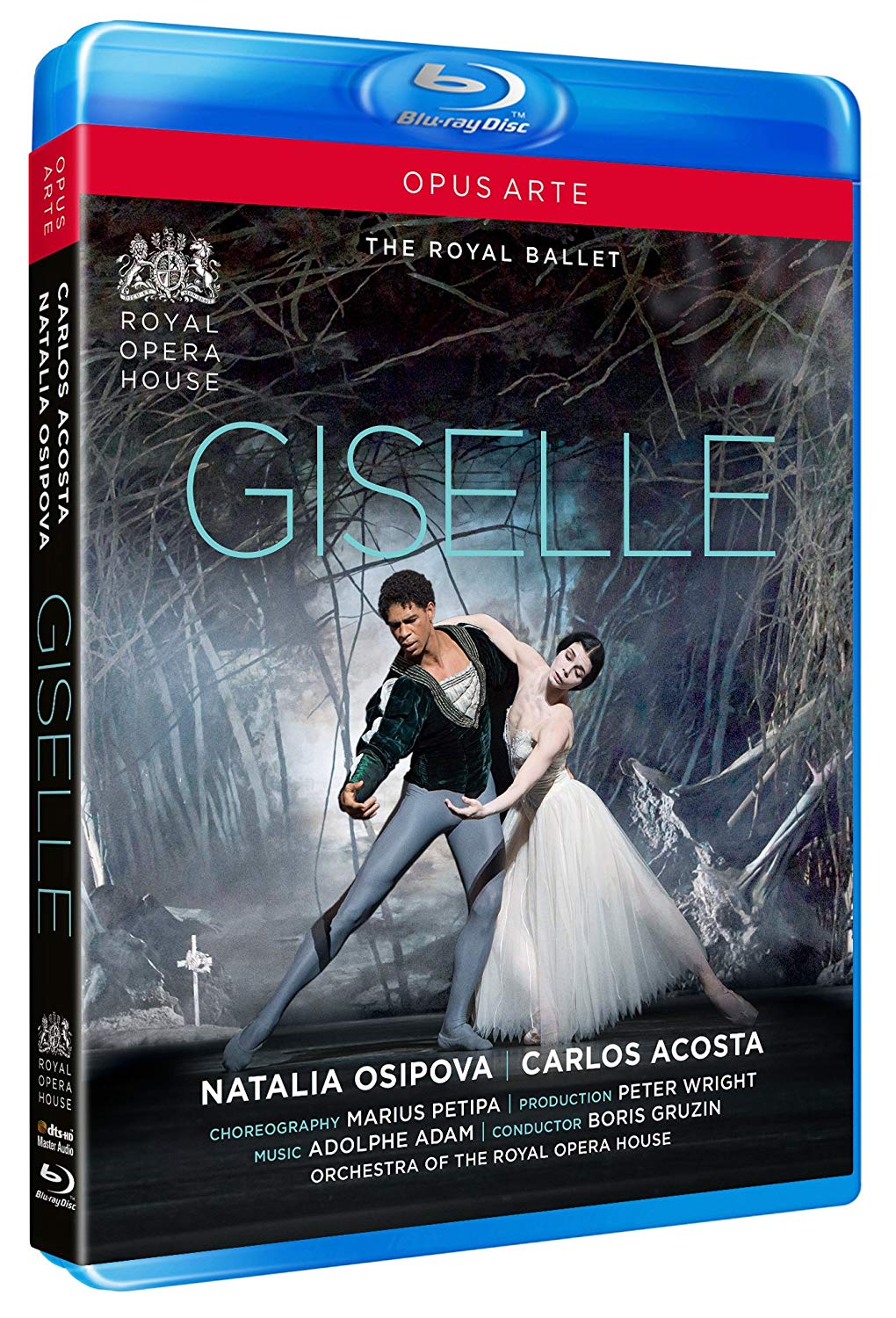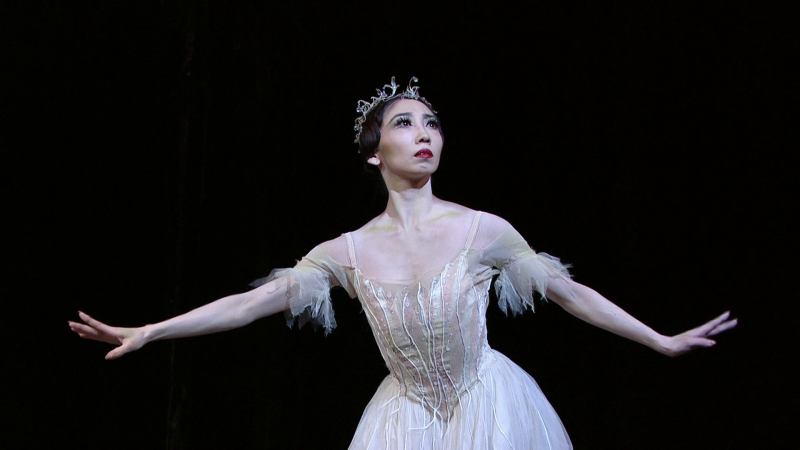Giselle ballet. Music by Adolphe Adam revised by Joseph Horovitz. Libretto by Théophile Gautier and Jules-Henri Vernoy de Saint-Georges. Choreography by Marius Petipa after Jean Coralli and Jules Perrot. Directed 2014 by Sir Peter Wright at the Royal Opera House. Stars Natalia Osipova (Giselle), Carlos Acosta (Count Albrecht), Thomas Whitehead (Hilarion), Deirdre Chapman (Berthe), Johannes Stepanek (Wilfred, Albrecht's Squire), Christopher Saunders (Duke of Courland), Christina Arestes (Bathilde, Courland's daughter), Alastair Marriott (Leader of the Hunt), Hikaru Kobayashi (Myrtha, Queen of the Wilis), Elisabeth Harrod (Moyna, Myrtha's attendant), Akane Takada (Zulme, Myrtha's attendant). Pas de Six danced by Yuhui Choe, Valentino Zucchetti, Francesca Hayward, Luca Acri, Yasmine Naghdi, and Marcelino Sambé). Boris Gruzin conducts the Orchestra of the Royal Opera House (Concert Master Peter Manning). Designs by John Macfarlane; lighting by Jennifer Tipton recreated by David Finn; staging by Christopher Carr. Directed for TV by Ross MacGibbon. Released 2014, disc has 5.1 dts-HD Master Audio sound. Grade: A-
This is the same production that was performed by the Royal Opera Ballet at the Royal Opera House in 2006 and published by Opus Arte in 2009. Why did Opus Arte (which belongs to the ROH) do a new Blu-ray of this? The stars in 2006 have mostly retired and how there's a new stable of dancers. My guess is that ROH management wanted to support its current dancers by giving them a change to shine in a new video of this famous ballet. What has changed in 8 years? Many small details have changed, and we will point out a few in our screenshots. And, of course, a fabulous performance by one star can have a big impact on the desirability of a disc.
So which version should you buy now, the 2006 performance or the 2014? And is the better of these choices as good as the venerable Giselle from the Paris Opera Ballet that was first published in 2009? We will try to answer these questions with the help of our screenshots. (By the way, in this review, I'll assume you already know the Giselle story. If you don't know the story, read some of our other Giselle reviews where we go into the story.)
—
Natalia Osipova is the new Giselle. Osipova has it all: beauty, acting skill, and incredible dancing ability. Her star is still rising. She did an amazing job in The Flames of Paris at the Bolshoi and in Notre-Dame de Paris at la Scala. Now it appears she has been recruited to give the ROB a female super-star (that they had trouble developing themselves). Carlos Acosta is the new Albrecht. He has had an astonishing career with more than 10 credits for Blu-rays reported on this website. (Go to the Search tool to see all this.) But he is fast approaching retirement, and his star is now setting into the western seas of choreography and ballet management. Here we see Giselle and Albrecht falling in love. Note how pretty the costumes are even in close-up:
If you will compare the next three screenshots below to the screenshots for the 2006 Royal Opera Ballet disc, you will see that Peter Wright brightened up the set a lot for his update. This in turn makes it much easier for the cameramen to get great high-resolution video images. Wright was no doubt encouraged to do this by the folks at Opus Arte:
Deirdre Chapman is the new Berthe, shown here explaining how the Wilis kill the young men they capture in the forest (the crossed wrists stand for "death"):
In 2006, the Royal Opera Ballet was good at creating a convincing story with careful personal direction of the dancers in the crowd scenes. But Wright reorganized these scenes (especially with the appearance of the royals) and made the directing even better. Everyone on stage received detailed instructions for every move and expression for each second of the drama. The result is a marvelous fusion of the arts of ballet, stage drama, and movie-making. Here Osipova is so fetching acting the role of the shy, innocent village girl. Christopher Saunders is the new Duke and Christina Arestes the new Bathilde, both impressive in their efforts to politely ingratiate themselves with the peasants:
Wright lets Giselle show off her 32 one-foot hops especially to the royal visitors, which helps explain why Bathilde was so charmed by Giselle. Note the joy on Giselle's face:
The next three screenshots lead up to Bathilde's gift of the beautiful necklace to Giselle. Through all of this, Osipova is adorable:
Bathilde asks her ladies-in-waiting on advice whether to give the necklace to the peasant girl. I picked this to show the wonderful costumes:
Later Albrecht's duplicity is revealed:
Giselle realizes her sweetheart is a Count whom she can never marry. The mad scene and suicide follow:
Now we are in Act 2. Here's Hikaru Kobayashi as Myrtha, Queen of the Wilis. This shot was actually taken from the last moments of the ballet when Myrtha hears the church bells and knows that the Wilis must return to their mysterious lodgings. Note the sleeves on Myrtha's dress. They have been washed 1000 times and now look like dish rags. Her dress and tiara have "spaghetti-design" elements that hark back, I think, to 1987 when spaghetti design was glorified in the the Anthony Dowell production of Swan Lake. Well, if the Queen of the Wilis has to wear this obsolete and worn-out dress, what rags will the corps dancers have to dress in?
I noted in my review of the 2006 Giselle that the white corps needed more drilling. They didn't get it. Compare the next 3 screenshots to similar images from the POB Giselle. Note that in London, the girls are lined up in ranks of 8 and each file has only 3 girls. This makes the stage look cluttered and ensures that the audience can't see if the longer lines are straight. In Paris the girls are lined up in ranks of 6, which looks more elegant. Then the files have 4 girls each, but this is no problem in Paris because the dancers have been drilled to point that they can line up anything. In London the cameras shoot from low positions so it's hard to see the alignment. In Paris the cameras shoot from the balcony so you can easily see every position of every girl all the time---they flaunt their perfection. In London, the conductor plays fast so that the audience has less time to really look at the formations. In Paris, the conductor slows the music down to give the audience more time to savor the perfection of key solos and the white formations (the Paris Act 2 is one minute and 14 seconds longer than in London):
Even props are important when a ballet is going to be made into an HDVD. Look at the lilies Albrecht here is taking to Giselle's grave. I went back to this scene in the the 2006 version. I'm pretty sure these are the exact same plastic lilies that were used 8 years prior and that they have been sitting in a hot warehouse ever since freezing and melting as the seasons roll by. In any event, these do not look like the flowers a Prince would take to the grave of his dead love:
Here, from the Paris Opera Ballet, is what Giselle's lilies should look like:
Giselle appears to Albrecht at the grave:
Now the Wilis have captured Albrecht and Giselle defends him:
I already commented on Myrtha's costume. At least Giselle doesn't have to wear the dirty sleeves. But does this dress fit her?
Now 3 shots from the Act 2 pas de deux. Acosta does fine in this. But there are also scenes where Albrecht is forced to dance and the male star gets to show his prowess in solo. One of these scenes is supposed to be a batterie (where the dancer jumps straight up and rapidly crosses his legs at the ankle before landing) of 30 leaps. Nicolas Le Riche at the Paris Opera Ballet does the full 30 leaps crisply to two rounds of applause from the audience. The best Acosta can do is 10 halting leaps—I get the impression that if he had to do 30, it might really kill him:
I love this shot where the Wilis are in retreat and Giselle shares her last moment with Albrecht until eternity:
So what are my answers to the questions posed earlier? I prefer the new Royal Opera Ballet Giselle ever so slightly over the 2006 version. Act 1 is distinctly improved in the 2014 version; Act 2 is about the same. I give the same A- to both.
I still prefer the Paris Opera Ballet Giselle performed in 2006 over all other HDVDs because of the magisterial Act 2. If a guest wanted to see Giselle, I might try to show Act 1 from the 2014 Royal Opera Ballet title and Act 2 from the Paris Opera Ballet—then you get the best girl and the best ghost.
Here are two official clips:
OR































